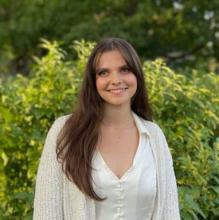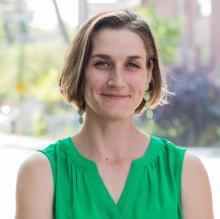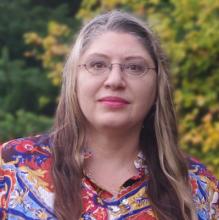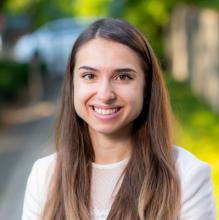Drawing from Indigenous sources of knowledge, and working together with expert weavers, Alison centers her work around the practice and outputs of Salish weavers as critically and politically engaged practices. Conceiving her work as an attempt to write art history that privileges local Indigenous knowledge and concepts, Alison engages with nine artwork by Salish weavers located across Canada and the US.
Research Description
A significant body of woven work has been generated by Salish weavers, and the past decade has seen an upsurge in exhibitions focused on Salish weaving in anthropological and history museums, Indigenous cultural centres, and contemporary art galleries. Salish weavings have shaped the visual vocabulary of urban spaces in and beyond Coast Salish territory since the 1960s. An international airport, a university, and a hotel complex are representative of sites where Salish weavings have been installed as public art. And yet, critical art historical discourse about Salish weaving is rare. Curious about how the weavings moved through diversely purposed spaces such as art galleries and anthropology museums, private collections, and Indigenous and non-Indigenous communities, I began to ask, what are the weavings capable of doing in each realm? What allows them to operate fluidly across multiple spaces without internal incongruity? The study will focus on nine public installations of Salish weaving, located in Vancouver and Burnaby, BC; Seattle, WA; Ottawa, ON and Montreal, QC. The study is aimed at better understanding how these particular weavings - installed between 1967 and 2019 - may be commenting on settler-colonialism and its institutions of governance, urban development, and the formation of the canon of Northwest Coast Indigenous art. As public art installations, what work do the weavings perform? Who and what informs their roles in these urban centres? As visible, material and performative pieces of cultural practice, how is Salish weaving critically engaged with settler-colonial institutions in unceded Salish territories? The project will center Squamish, Musqueam, Tsleil-Waututh and Sto:lo methods and theories, and will challenge existing categorizations of art and visual culture that have marginalized these weaving practices. Grounded by Indigenous feminist methods, it investigates how contemporary Salish weaving became an active participant in new spaces in the late 20th and early 21st century on the Pacific Northwest Coast. The project spans art history, anthropology and indigenous studies to approach the work of Salish weavers as critically and politically engaged practices, something yet to be addressed in art history. I want to shift the research from an individual to a collaborative process, from “writing about” to “thinking with” Salish weavers. In this way, it may be possible to view Salish weaving as operating in relation with art, rather than being limited by this category. The expert Salish weavers who created the focal installations will be engaged in shaping research processes and outcomes that respect them as knowledge holders. It will incorporate experiential and affective learning, listening to shared stories, engaging in the practice, individual interviews, group discussions, and focusing on the knowledge the weavers may choose to share, and it will take their direction regarding research outcomes of value to them and their practices. The research aims to engage with this community of interest and to give back, rather than being focused on the goals of arts institutions. It also aims to address ongoing calls for art historical writing that appropriately privileges local Indigenous knowledge and concepts. The project will make a critical inquiry into the position of Indigenous textiles as public art that engages with Salish knowledge and philosophies in the analysis and interpretation of Salish weaving as an Indigenous critique of institutions. It will address the underlying historical and settler-colonial structures that shape Coast Salish and Northwest Coast Indigenous art as canons, and how they continue to shape perspectives on public art in the region.
What does being a Public Scholar mean to you?
It means moving outward from the library, the archive and the gallery as spaces for research, to work with the guidance and knowledge of this community of weavers, with the opportunity to co-design research processes and outcomes that will meet their interests and needs as practitioners, teachers, students and scholars.
In what ways do you think the PhD experience can be re-imagined with the Public Scholars Initiative?
It can allow for the formation of expanded networks with and between communities of practitioners of knowledge, well beyond my own discipline and the sphere of the university. It can also expand a broader understanding of where knowledge lives and how it is cared for by communities.
How do you envision connecting your PhD work with broader career possibilities?
I am open to future careers with cultural institutions (broadly defined, and including universities of course) in many capacities, especially with those that would support and sustain decolonial or non-colonial approaches, policies and projects.
How does your research engage with the larger community and social partners?
The research will engage with expert Salish weavers through interviews, but also seeks to bring them together as a community of interest through workshops and/or group conversations in which we will co-develop research outcomes that they would find valuable. I continue to be involved in workshops and other events in which these weavers are leaders, teachers and guides. As a community of interest situated within and across several local Indigenous communities, the research is also making connections with those communities.
Why did you decide to pursue a graduate degree?
I chose to return to graduate school after 12+ years of work in the field of research proposal and partnership grant development with Canadian universities, where I was able to provide guidance and support to researchers in the complex processes and institutional expectations that surround research funding. Exposure to a vast range of research and expertise across these institutions was an incredible gift. My return to graduate studies was a choice to devote this part of my life to my own knowledge development, and my own research interests.
Why did you choose to come to British Columbia and study at UBC?
My prior work experience with UBC had given me a strong sense of the depth and breadth of research expertise within the Faculty of Arts. In both my MA and PhD programs, I have been fortunate to work with supportive faculty members in Art History, Visual Art and Theory (AHVA), Anthropology, and First Nations and Indigenous Studies (FNIS). As I learned more about the expert weavers situated within the region, and collections of 20th-21st century Salish weavings at places like the Museum of Anthropology (MOA) and the Museum of Vancouver (MOV), it made sense to live and study locally, in the territories of the Musqueam, Squamish, Sto:lo and Tsleil-Waututh peoples, all of whom are vital to the sustenance and resurgence of Salish weaving practices.




